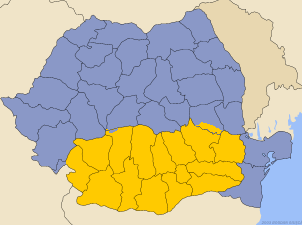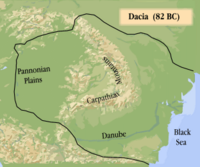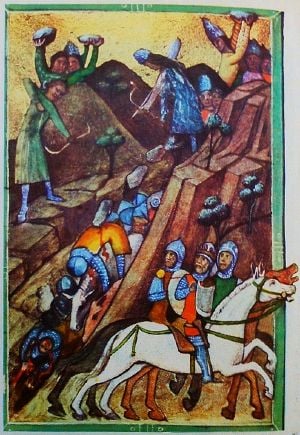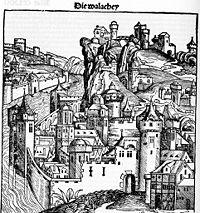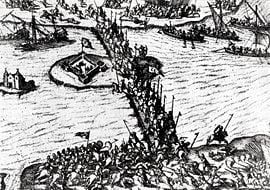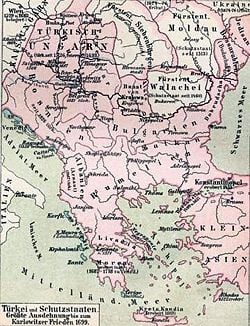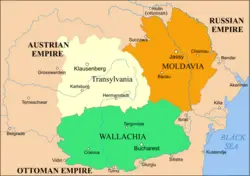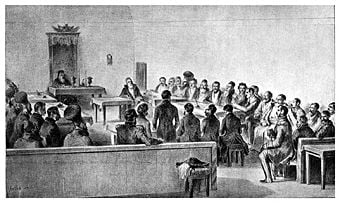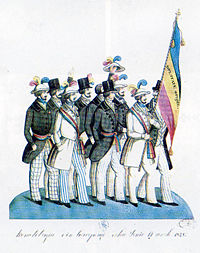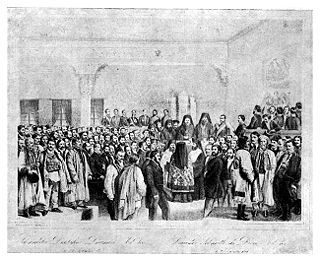Walachia
Wallachia (also spelled Walachia; Romanian: Ţara Românească, or "The Romanian Land") is a historical and geographical region of Romania. It is situated north of the Danube and south of the Southern Carpathians.
The name Wallachia, generally not used by Romanians themselves (but present in some contexts as Valahia or Vlahia), is derived from the Valachs—a word of German origin also present as the Slavic Vlachs - used by foreigners in reference to Romanians.
The principality of Wallachia was founded in 1290 by Radu Negru (Ralph the Black). Initially dominated by Hungary, Charles I was defeated in 1330 by Basarab I, securing the independence of Wallachia. In 1391, the kingdom was forced to pay tribute to the Ottoman Empire and later Turkish suzerainty was acknowledged by Prince Mircea the Old in 1417. This allowed Wallachia to keep its own dynasty, territory, and religion, even though domestic and foreign policy was handled by the Ottomans.
Resistance to Ottoman hegemony continued over time, resulting in an unstable political structure that caused the Turks to select Greek administrators to govern. Increasing influence by Russia resulted in the principality being placed under Russian protection in 1774, despite the Turkish suzerainty. In 1821, an uprising caused the end of the Turkish phanariote.[1] The area was under Russian protectorate until 1856 and in 1859, Wallachia voted to unite with Moldavia to form the state of Romania.
Geography
Wallachia is situated north of the Danube (and of present-day Serbia and Bulgaria) and south of the Southern Carpathians, and is traditionally divided between Muntenia in the east (as the political center, Muntenia is often understood as being synonymous with Wallachia), and Oltenia (a former banat)[2] in the west. The division line between the two is the Olt River.
Wallachia's traditional border with Moldavia coincided with the Milcov River for most of its length. To the east, over the Danube north-south bend, Wallachia neighbors Dobruja (Northern Dobruja). Over the Carpathians, Wallachia shared a border with Transylvania; Wallachian princes have long held possession of areas north of this line (Amlaş, Ciceu, Făgăraş, and Haţeg), which are generally not considered part of Wallachia-proper.
The capital city changed over time, from Câmpulung to Curtea de Argeş, then to Târgovişte and, after the late 1500s, to Bucharest.
History
From Roman rule to the state's establishment
In the Second Dacian War (105 C.E.) western Oltenia became part of the Roman province of Dacia, with parts of Wallachia included in the Moesia Inferior province. The Roman limes was initially built along the Olt River (119), before being moved slightly to the east in the second century — during which time it stretched from the Danube up to Rucăr in the Carpathians. The Roman line fell back to the Olt in 245, and, in 271, the Romans pulled out of the region.
The area was subject to Romanization sometime during the Migration Period, when most of present-day Romania was also subject to the presence of Goths [3]and Sarmatian peoples [4]known as the Mureş-Cerneahov culture, followed by waves of other nomadic peoples. In 328, the Romans built a bridge between Sucidava (Celei) and Oescus (near Gigen) which indicates that there was a significant trade with the peoples north of the Danube (a short period of Roman rule in the area is attested under Emperor Constantine I). The Goths attacked the Roman Empire south of the Danube in 332, settling north of the Danube then later to the south. The period of Goth rule ended when the Huns [5]arrived in the Pannonian Plain, and, under Attila, attacked and destroyed some 170 settlements on both sides of the Danube River.
Byzantine influence is evident during the fifth to sixth century, such as the site at Ipoteşti-Cândeşti, but from the second half of the sixth century and in the seventeenth century Slavic peoples crossed the territory of Wallachia and settled in it, on their way to Byzantium, occupying the southern bank of the Danube. In 593, the Byzantine commander-in-chief Priscus defeated Slavs, Avars, and Gepids on future Wallachian territory, and, in 602, Slavs suffered a crucial defeat in the area; Flavius Mauricius Tiberius, who ordered his army to be deployed north of the Danube, encountered his troops' strong opposition.
Wallachia was under the control of the First Bulgarian Empire from its establishment in 681, until approximately the Magyar conquest of Transylvania at the end of the tenth century. With the decline and subsequent fall of the Bulgarian state to Byzantium (in the second half of the tenth century up to 1018), Wallachia came under the control of the Pechenegs (a Turkic people) who extended their rule west through the tenth and eleventh century, until defeated around 1091, when the Cumans of southern Russia took control of the lands of Moldavia and Wallachia. Beginning with the tenth century, Byzantine, Bulgarian, Hungarian, and later Western sources mention the existence of small polities, possibly peopled by, among others, Vlachs/Romanians led by knyazes and voivodes - at first in Transylvania, then in the twelfth-thirteenth centuries in the territories east and south of the Carpathian Mountains.
In 1241, during the Mongol invasion of Europe, Cuman domination was ended - a direct Mongol rule over Wallachia was not attested, but it remains probable. Part of Wallachia was probably briefly disputed by the Hungarian Kingdom and Bulgarians in the following period, but it appears that the severe weakening of Hungarian authority during the Mongol attacks contributed to the establishment of the new and stronger polities attested in Wallachia for the following decades.
Creation
One of the first written evidence of local Voivodes is in connection with Litovoi (1272), who ruled over land on each side of the Carpathians (including Făgăraş in Transylvania), and refused to pay tribute to the Hungarian King Ladislaus IV. His successor was his brother Bărbat (1285-1288). The continuing weakening of the Hungarian state by further Mongol invasions (1285-1319) and the fall of the Árpád dynasty opened the way for the unification of Wallachian polities, and to independence from Hungarian rule.
Wallachia's creation, held by local traditions to have been the work of one Radu Negru, is historically connected with Basarab I (1310-1352), who rebelled against Charles I of Hungary and took up rule on either side of the Olt River, establishing his residence in Câmpulung as the first ruler in the House of Basarab. Basarab refused to grant Hungary the lands of Făgăraş, Amlaş and the Banat of Severin, defeated Charles in the Battle of Posada (1330), and extended his lands to the east, to comprise lands as far as Kilia (in the Bujak, as the origin of Bessarabia); rule over the latter was not preserved by following princes, as Kilia fell to the Nogais ca. 1334.
Basarab was succeeded by Nicolae Alexandru, followed by Vladislav I. Vladislav attacked Transylvania after Louis I occupied lands south of the Danube, conceded to recognize him as overlord in 1368, but rebelled again in the same year; his rule also witnessed the first confrontation between Wallachia and the Ottoman Turks (a battle in which Vladislav was allied with Ivan Shishman of Bulgaria). Under Radu I and his successor Dan I, the realms in Transylvania and Severin continued to be disputed with Hungary.
1400-1600
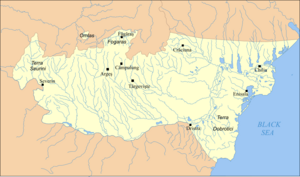
As the entire Balkan Peninsula become an integral part of the emerging Ottoman Empire (a process which concluded with the fall of Constantinople to Sultan Mehmed II in 1453). Wallachia became engaged in frequent confrontations and, in the final years of Mircea the Elder's reign, became an Ottoman subject. Mircea (reigned 1386-1418), initially defeated the Ottomans in several battles (including that of Rovine in 1394), driving them away from Dobruja and briefly extending his rule to the Danube Delta, Dobruja and Silistra (ca.1400-1404). He oscillated between alliances with Sigismund of Hungary and Jagiellon Poland (taking part in the Battle of Nicopolis), and accepted Ottoman suzerainty in 1415, after Mehmed I took control of Turnu and Giurgiu — the two ports remained part of the Ottoman state, with brief interruptions, until 1829. In 1418-1420, Mihail I defeated the Ottomans in Severin, only to be killed in battle by the counter-offensive; in 1422, the danger was averted for a short while when Dan II inflicted a defeat on Murad II with the help of Pippo Spano.
The peace signed in 1428 inaugurated a period of internal crisis, as Dan had to defend himself against Radu Prasnaglava, who led the first in a series of boyar coalitions against established princes (in time, these became overtly pro-Ottoman in answer to repression). Victorious in 1431 (the year when the boyar-backed Alexandru I Aldea took the throne), boyars were dealt successive blows by Vlad II Dracul (1436-1442; 1443-1447), who nevertheless attempted to compromise between the Porte and the Holy Roman Empire.
The following decade was marked by the conflict between the rival houses of Dăneşti and Drăculeşti, the influence of John Hunyadi, Regent of the Kingdom of Hungary, and, after the neutral reign of Vladislav II, by the rise of Vlad III Dracula. Vlad, during whose rule Bucharest was first mentioned as a princely residence, exercised terror on rebellious boyars, cut off all links with the Ottomans, and, in 1462, defeated Mehmed II's offensive during The Night Attack before being forced to retreat to Târgovişte and accepting to pay an increased tribute. His parallel conflicts with the pretenders Radu cel Frumos and Laiotă Basarab brought occupations of Wallachia by the troops of Matthias Corvinus of Hungary and the Moldavian prince Stephen III (1473; 1476-1477). Radu the Great (1495-1508) reached several compromises with the boyars, ensuring a period of internal stability that contrasted his clash with Bogdan the Blind of Moldavia.
The late 1400s saw the ascension of the powerful Craioveşti family, virtually independent rulers of the Oltenian banat, who sought Ottoman support in their rivalry with Mihnea cel Rău (1508-1510) and replaced him with Vlăduţ; after the latter proved to be hostile to the bans, the House of Basarab formally ended with the rise of Neagoe Basarab, a Craioveşti. Neagoe's peaceful rule (1512-1521), noted for its cultural aspects (the building of the Curtea de Argeş Cathedral and Renaissance influences), also saw an increase in influence for the Saxon merchants in Braşov and Sibiu, and Wallachia's alliance with Louis II of Hungary. Under Teodosie, the country was again under a four-month-long Ottoman occupation, a military administration which seemed to be an attempt to create a Wallachian Pashaluk. This danger rallied all boyars in support of Radu de la Afumaţi (four rules between 1522 and 1529), who lost the battle after an agreement between the Craioveşti and Sultan Suleiman the Magnificent; Prince Radu eventually confirmed Süleyman's position as suzerain, and agreed to pay an even higher tribute.
Ottoman suzerainty remained virtually unchallenged throughout the following 90 years. Radu Paisie, who was deposed by Süleyman in 1545, ceded the port of Brăila to Ottoman administration in the same year; his successor Mircea Ciobanul (1545-1554; 1558-1559), a prince without any claim to noble heritage, was imposed on the throne and consequently agreed to a decrease in autonomy (increasing taxes and carrying out an armed intervention in Transylvania — supporting the pro-Turkish John Zápolya). Conflicts between boyar families became stringent after the rule of Pătraşcu cel Bun, and boyar ascendancy over rulers was obvious under Petru the Younger (1559-1568; a reign dominated by Doamna Chiajna and marked by huge increases in taxes), Mihnea Turcitul, and Petru Cercel.
The Ottoman Empire increasingly relied on Wallachia and Moldavia for the supply and maintenance of its military forces; the local army, however, soon disappeared due to the increased costs and the much more obvious efficiency of mercenary troops.
1600s
Initially profiting from Ottoman support, Michael the Brave ascended to the throne in 1593, and attacked the troops of Murad III north and south of the Danube in an alliance with Transylvania's Sigismund Báthory and Moldavia's Aron Vodă. He soon placed himself under the suzerainty of Rudolf II, the Holy Roman Emperor, and, in 1599-1600, intervened in Transylvania against Poland's king Sigismund III Vasa, placing the region under his authority; his brief rule also extended to Moldavia later in the following year. Following Michael's downfall, Wallachia was occupied by the Polish-Moldavian army of Simion Movilă, who held the region until 1602, and was subject to Nogai attacks in the same year.
The last stage in the Growth of the Ottoman Empire brought increased pressures on Wallachia: political control was accompanied by Ottoman economical hegemony, the discarding of the capital in Târgovişte in favor of Bucharest (closer to the Ottoman border, and a rapidly growing trade center), the establishment of serfdom under Michael the Brave as a measure to increase manorial revenues, and the decrease in importance of low-ranking boyars (threatened with extinction, they took part in the seimeni rebellion of 1655). Furthermore, the growing importance of appointment to high office in front of land ownership brought about an influx of Greek and Levantine families, a process already resented by locals during the rules of Radu Mihnea in the early 1600s. Matei Basarab, a boyar appointee, brought a long period of relative peace (1632-1654), with the noted exception of the 1653 Battle of Finta, fought between Wallachians and the troops of Moldavian prince Vasile Lupu — ending in disaster for the latter, who was replaced with Prince Matei's favourite, Gheorghe Ştefan, on the throne in Iaşi.
A close alliance between Gheorghe Ştefan and Matei's successor Constantin Şerban was maintained by Transylvania's George II Rákóczi, but their designs for independence from Ottoman rule were crushed by the troops of Mehmed IV in 1658-1659. The reigns of Gheorghe Ghica and Grigore I Ghica, the sultan's favorites, signified attempts to prevent such incidents; however, they were also the onset of a violent clash between the Băleanu and Cantacuzino boyar families, which was to mark Wallachia's history until the 1680s. The Cantacuzinos, threatened by the alliance between the Băleanus and the Ghicas, backed their own choice of princes (Antonie Vodă din Popeşti and George Ducas) before promoting themselves — with the ascension of Şerban Cantacuzino (1678-1688).
Russo-Turkish Wars and the Phanariotes
Wallachia became a target for Habsburg incursions during the last stages of the Great Turkish War ca.1690, when the ruler Constantin Brâncoveanu secretly and unsuccessfully negotiated an anti-Ottoman coalition. Brâncoveanu's reign (1688-1714), noted for its late Renaissance cultural achievements, also coincided with the rise of Imperial Russia under Emperor Peter the Great — he was approached by the latter during the Russo-Turkish War of 1710-1711, and lost his throne and life sometime after sultan Ahmed III caught news of the negotiations. Despite his denunciation of Brâncoveanu's policies, Ştefan Cantacuzino attached himself to Habsburg projects and opened the country to the armies of Prince Eugene of Savoy; he was himself deposed and executed in 1716.
Immediately following the deposition of Prince Ştefan, the Ottomans renounced the purely nominal elective system (which had by then already witnessed the decrease in importance of the Boyar Divan over the sultan's decision), and princes of the two Danubian Principalities were appointed from the Phanariotes of Istanbul. Inaugurated by Nicholas Mavrocordatos in Moldavia after Dimitrie Cantemir, Phanariote rule was brought to Wallachia in 1715 by the very same ruler. The tense relations between boyars and princes brought a decrease in the number of taxed people (as a privilege gained by the former), a subsequent increase in total taxes, and the enlarged powers of a boyar circle in the Divan.
In parallel, Wallachia became the battleground in a succession of wars between the Ottomans on one side and Russia or the Habsburg Monarchy on the other. Mavrocordatos himself was deposed by a boyar rebellion, and arrested by Habsburg troops during the Austro-Turkish War of 1716-18, as the Ottomans had to concede Oltenia to Charles VI of Austria (the Treaty of Passarowitz). The region, subject to an enlightened absolutist rule that soon disenchanted local boyars, was returned to Wallachia in 1739 (the Treaty of Belgrade, upon the close of the Austro-Turkish War of 1737-39). Prince Constantine Mavrocordatos, who oversaw the new change in borders, was also responsible for the effective abolition of serfdom in 1746 (which put a stop to the exodus of peasants into Transylvania); during this period, the ban of Oltenia moved his residence from Craiova to Bucharest, signaling, alongside Mavrocordatos' order to merge his personal treasury with that of the country, a move towards centralism.
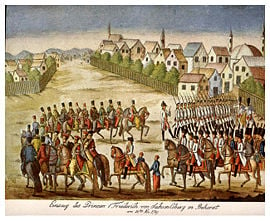
In 1768, during the Fifth Russo-Turkish War, Wallachia was placed under its first Russian occupation (helped along by the rebellion of Pârvu Cantacuzino). The Treaty of Kucuk Kaynarca (1774) allowed Russia to intervene in favor of Eastern Orthodox Ottoman subjects, curtailing Ottoman pressures — including the decrease in sums owed as tribute— and, in time, relatively increasing internal stability while opening Wallachia to more Russian interventions.
Habsburg troops, under Prince Josias of Coburg, again entered the country during the Russo-Turkish-Austrian War, deposing Nicholas Mavrogenis in 1789. A period of crisis followed the Ottoman recovery: Oltenia was devastated by the expeditions of Osman Pazvantoğlu, a powerful rebellious pasha whose raids even caused prince Constantine Hangerli to lose his life on suspicion of treason (1799), and Alexander Mourousis to renounce his throne (1801). In 1806, the Russo-Turkish War of 1806-1812 was partly instigated by the Porte's deposition of Constantine Ypsilantis in Bucharest — in tune with the Napoleonic Wars, it was instigated by the French Empire, and also showed the impact of the Treaty of Kucuk Kaynarca (with its permissive attitude towards Russian political influence in the Danubian Principalities); the war brought the invasion of Mikhail Andreyevich Miloradovich.
After the Peace of Bucharest, the rule of Ioan Gheorghe Caragea, although remembered for a major plague epidemic, was notable for its cultural and industrial ventures. During the period, Wallachia increased its strategic importance for most European states interested in supervising Russian expansion; consulates were opened in Bucharest, having an indirect but major impact on Wallachian economy through the protection they extended to sudiţi traders (who soon competed successfully against local guilds).
From Wallachia to Romania
The death of prince Alexander Soutzos in 1821, coinciding with the outbreak of the Greek War of Independence, established a boyar regency which attempted to block the arrival of Scarlat Callimachi to his throne in Bucharest. The parallel uprising in Oltenia, carried out by the Pandur leader Tudor Vladimirescu, although aimed at overthrowing the ascendancy of Greeks, compromised with the Greek revolutionaries in the Filiki Eteria and allied itself with the regents, while seeking Russian support.
On March 21, 1821, Vladimirescu entered Bucharest. For the following weeks, relations between him and his allies worsened, especially after he sought an agreement with the Ottomans; Eteria's leader Alexander Ypsilantis, who had established himself in Moldavia and, after May, in northern Wallachia, viewed the alliance as broken — he had Vladimirescu executed, and faced the Ottoman intervention without Pandur or Russian backing, suffering major defeats in Bucharest and Drăgăşani (before retreating to Austrian custody in Transylvania). These violent events, which had seen the majority of Phanariotes siding with Ypsilantis, made Sultan Mahmud II place the Principalities under its occupation (evicted by a request of several European powers), and sanction the end of Phanariote rules: in Wallachia, the first prince to be considered a local one after 1715 was Grigore IV Ghica. Although the new system was confirmed for the rest of Wallachia's existence as a state, Ghica's rule was abruptly ended by the devastating Russo-Turkish War of 1828-1829.
The 1829 Treaty of Adrianople, without overturning Ottoman suzerainty, placed Wallachia and Moldavia under Russian military rule, awarding them the first common institutions and the semblance of a constitution. Wallachia was returned ownership of Brăila, Giurgiu (both of which soon developed into major trading cities on the Danube), and Turnu Măgurele. The treaty also allowed Moldavia and Wallachia to freely trade with countries other than the Ottoman Empire, which signalled substantial economic and urban growth, as well as improving the peasant situation. Many of the provisions had been specified by the 1826 Akkerman Convention between Russia and the Ottomans (it had never been fully implemented in the three-year interval).
The duty of overseeing of the Principalities was left to Russian general Pavel Kiselyov; this interval was marked by a series of major changes, including the reestablishment of a Wallachian Army (1831), a tax reform (which nonetheless confirmed tax exemptions for the privileged), as well as major urban works in Bucharest and other cities. In 1834, Wallachia's throne was occupied by Alexandru II Ghica — a move in contradiction with the Adrianople treaty, as he had not been elected by the new Legislative Assembly; removed by the suzerains in 1842, he was replaced with an elected prince, Gheorghe Bibescu.
Opposition to Ghica's arbitrary and highly conservative rule, together with the rise of liberal and radical currents, was first felt with the protests voiced by Ion Câmpineanu (quickly repressed); subsequently, it became increasingly conspiratorial, and centered on those secret societies created by young officers such as Nicolae Bălcescu and Mitică Filipescu.
Frăţia, a clandestine movement created in 1843, began planning a revolution to overthrow Bibescu and repeal Regulamentul Organic in 1848 (inspired by the European rebellions of the same year). Their pan-Wallachian coup d'état was initially successful only near Turnu Măgurele, where crowds cheered the Islaz Proclamation (June 21); among others, the document called for political freedoms, independence, land reform, and the creation of a national guard. On June 11 and 12, the movement was successful in deposing Bibescu and establishing a Provisional Government. Although sympathetic to the anti-Russian goals of the revolution, the Ottomans were pressured by Russia into repressing it: Ottoman troops entered Bucharest on September 13. Russian and Turkish troops, present until 1851, brought Barbu Dimitrie Ştirbei to the throne, during which interval most participants in the revolution were sent into exile.
Briefly under renewed Russian occupation during the Crimean War, Wallachia and Moldavia were given a new status with a neutral Austrian administration (1854-1856) and the Treaty of Paris: a tutelage shared by Ottomans and a Congress of Great Powers (the United Kingdom of Great Britain and Ireland, the Second French Empire, the Kingdom of Piedmont-Sardinia, the Austrian Empire, Prussia, and, albeit never again fully, Russia), with a kaymakam-led internal administration. The emerging movement for a union of the Danubian Principalities (a demand first voiced in 1848, and a cause cemented by the return of revolutionary exiles) was advocated by the French and their Sardinian allies, supported by Russia and Prussia, but was rejected or suspicioned by all other overseers.
After an intense campaign, a formal union was ultimately granted: nevertheless, elections for the ad-hoc divans of 1859 profited from a legal ambiguity (the text of the final agreement specified two thrones, but did not prevent any single person from simultaneously taking part in and winning elections in both Bucharest and Iaşi). Alexander John Cuza, who ran for the unionist Partida Naţională, won the elections in Moldavia on January 5; Wallachia, which was expected by the unionists to carry the same vote, returned a majority of anti-unionists to its divan.
Those elected changed their allegiance after a mass protest of Bucharest crowds, and Cuza was voted prince of Wallachia on February 5 (January 24 Old Style), consequently confirmed as Domnitor of the United Principalities of Wallachia and Moldavia (of Romania from 1861). Internationally recognized only for the duration of his reign, the union was irreversible after the ascension of Carol I in 1866 (coinciding with the Austro-Prussian War, it came at a time when Austria, the main opponent of the decision, was not in a position to intervene).
Notes
- ↑ One of the Greeks of Constantinople who after the Turkish conquest became powerful in clerical and other offices under Turkish patronage, controlling much of the government.
- ↑ A region of southeast-central Europe extending across western Romania, northeast Serbia, and southern Hungary.
- ↑ Germanic people who invaded the Roman Empire in the early centuries of the Christian era.
- ↑ An ancient region of eastern Europe northeast of the Black Sea. The Sarmatian people occupied the area after the fourth century B.C.E. and fled across the Carpathian Mountains and along the Danube River after the onslaught of the Huns. The term is also applied to the territory between the Vistula and Volga rivers during the time of the Roman Empire.
- ↑ A tribe from western Asia who conquered much of central and eastern Europe during the fifth century. The Huns were known for their cruelty and destructiveness.
- ↑ Petre Dan. Hotarele românismului în date. (Litera International, 2005, ISBN 973675278X), 32, 34
ReferencesISBN links support NWE through referral fees
- Buza, Maria, and Taraful Ciuleandra. The Gypsies of Walachia. (Audio CD). Arc Music, 2001. ASIN B00005RT1K
- Doherty, P.C. Drakulya: Being an Account of the Life of Drakulya, Prince of Wallachia and the Bloody Prince that Shaped the Legend. Post Morten Books, 1997. ASIB B000X8P9VO
- East, W. Gordon. The Union of Moldavia and Wallachia, 1859: An Episode in Diplomatic History. Cambridge University Press, 1929. ASIN B0000H46TFO
- Pleshoyano, Dan V. Colonel Nicolae Plesoianu and the Regeneration Movement in Wallachia. East European Monographs, 1991. ISBN 978-0880332071
- Wilkinson, William. Account of the Principalities of Wallachia and Moldavia. Ayer Publishing Company, 1971. ISBN 978-0405027796
- All definitions were found at www.dictionary.com.
External links
- The Romanian Group for an Alternative History Website. www.patzinakia.ro. Retrieved November 20, 2007.
Credits
New World Encyclopedia writers and editors rewrote and completed the Wikipedia article in accordance with New World Encyclopedia standards. This article abides by terms of the Creative Commons CC-by-sa 3.0 License (CC-by-sa), which may be used and disseminated with proper attribution. Credit is due under the terms of this license that can reference both the New World Encyclopedia contributors and the selfless volunteer contributors of the Wikimedia Foundation. To cite this article click here for a list of acceptable citing formats.The history of earlier contributions by wikipedians is accessible to researchers here:
The history of this article since it was imported to New World Encyclopedia:
Note: Some restrictions may apply to use of individual images which are separately licensed.
